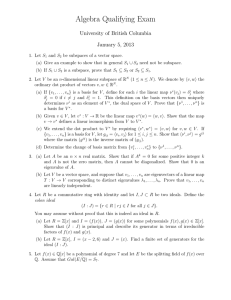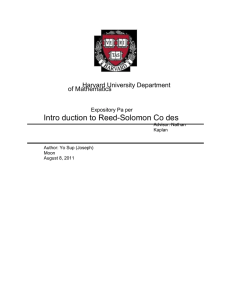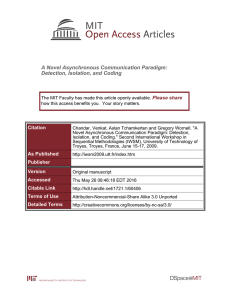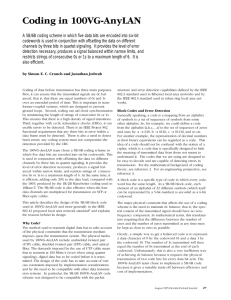Math 342, Spring Term 2009 Pre-Final Sheet April 13, 2009
advertisement
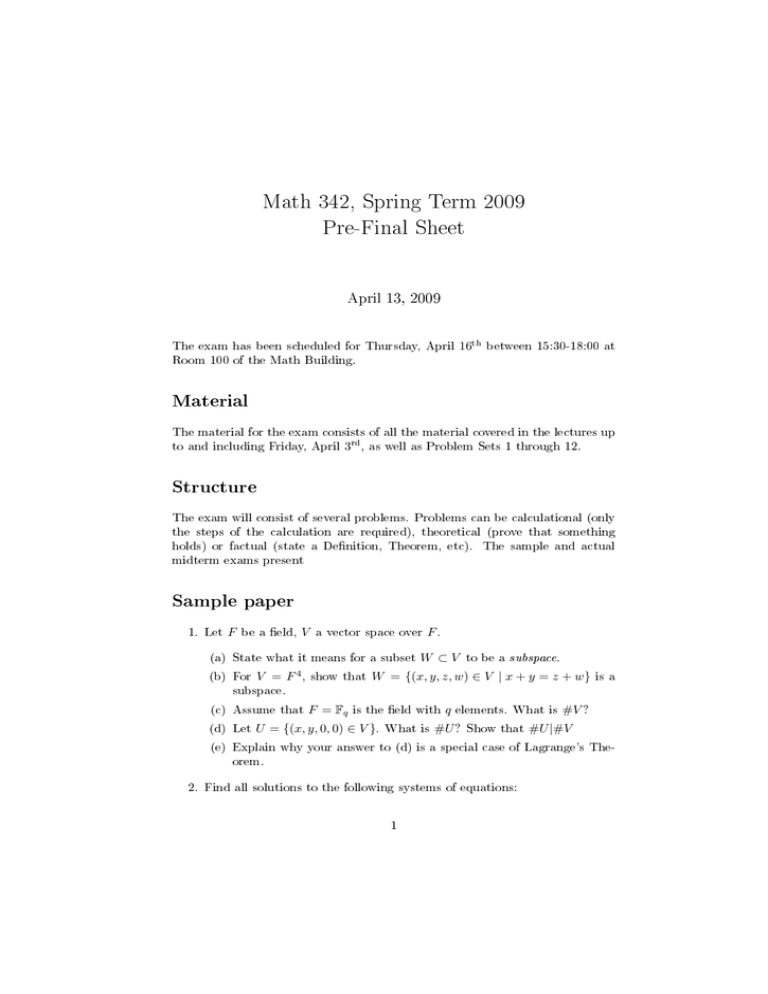
Math 342, Spring Term 2009
Pre-Final Sheet
April 13, 2009
The exam has been scheduled for Thursday, April 16th between 15:30-18:00 at
Room 100 of the Math Building.
Material
The material for the exam consists of all the material covered in the lectures up
to and including Friday, April 3rd , as well as Problem Sets 1 through 12.
Structure
The exam will consist of several problems. Problems can be calculational (only
the steps of the calculation are required), theoretical (prove that something
holds) or factual (state a Denition, Theorem, etc). The sample and actual
midterm exams present
Sample paper
1. Let F be a eld, V a vector space over F .
(a) State what it means for a subset W ⊂ V to be a
subspace.
(b) For V = F , show that W = {(x, y, z, w) ∈ V | x + y = z + w} is a
subspace.
4
(c) Assume that F = Fq is the eld with q elements. What is #V ?
(d) Let U = {(x, y, 0, 0) ∈ V }. What is #U ? Show that #U |#V
(e) Explain why your answer to (d) is a special case of Lagrange's Theorem.
2. Find all solutions to the following systems of equations:
1
(a) 4x ≡ 5 (12), where x ∈ Z.
(
[5]10 x + [3]10 y ≡ [2]10
, where x, y ∈ Z/10Z
(b)
[4]10 x + y = [0]10
(c) x2 = [2]3 , x ∈ Z/3Z.
3. PS1 problem 4
4. PS3 problem 9
5. PS10 problem 5.
1 1 2 0
6. Let H =
∈ M2×4 (F3 ) and let C ⊂ F43 be the code dened
0 2 1 1
by C = {v | Hv = 0}.
(a) For
any
x, y ∈ F3 show that there is are unique z, w ∈ F3 so that
x
y
z ∈ C.
w
(b) Write a
for thiscode.This matrix will represent
x
y
x
the encoding function
7→
z where z, w are as in part
y
w
(a).
generating matrix
(c) What is the
weight
of this code?
(d) Can this code correct errors?
7. (RS codes)
(a) Given integers k ≤ n, a nite eld F , and a subset X ⊂ F of size
n, dene the Reed-Solomon code of dimension k in F n given by
evaluation at X .
(b) Show that the code you dened has weight at least n − k + 1.
(c) Let F = F7 , k = 2, n = 5. You have received the vector v 0 =
(2, 6, 0, 0, 4) ∈ F57 which (up to transmission errors) represents the
values of a linear polynomial at the points X = {1, 2, 3, 4, 5} ∈ F7 .
Which linear polynoimal is the maximum likelihood decoding of this
transmission? Prove your claim.
8. The group of rigid symmetries of the square is a subgroup D4 ⊂ S4 of
order 8. In contains a cyclic subgroup of order 4 the rotations which
we will denote C4 . D4 also contains the reection by a diagonal, which we
denote π . Using Lagrange's Theorem show that every symmetry of the
square is either of the form ρ or πρ for some rotation ρ ∈ C4 .
2
Sample solutions
1. Let F be a eld, V a vector space over F .
(a) A subset W ⊂ V is a subspace if it is non-empty and is closed under
addition and under multiplication by scalars.
(b) If x = y = z = w = 0 then clearly x + y = z + w so 0 ∈ W . Also,
if (x, y, z, w) , (x0 , y 0 , z 0 , w0 ) ∈ W and α ∈ F then the associtativity
and commutativity of addition in F show that (x + x0 ) + (y + y 0 ) =
(x + y) + (x0 + y 0 ) while (z + z 0 ) + (w + w0 ) = (z + w) + (z 0 + w0 ). Since
(x + y) = (z + w) and (x0 + y 0 ) = (z 0 + w0 ) it follows that (x + x0 ) +
(y + y 0 ) = (z + z 0 ) + (w + w0 ), that is that (x, y, z, w) + (x0 , y 0 , z 0 , w0 ) =
(x + x0 , y + y 0 , z + z 0 , w + w0 ) ∈ W . We also have α(x + y) = α(z + w).
By the distributive law in F we have αx + αy = αz + αw, that is
that α(x, y, z, w) = (αx, αy, αz, αw) ∈ W .
(c) V is the space of 4-tuples of elements drawn from a set of size q , so
#V = q 4 .
(d) Similarly, #U = q 2 which divides its square q 4 .
(e) U ⊂ V is a subspace. In particular, it is a subset of V containing the
zero vector and closed under addition. Thinking only of the additive
group (V, 0, +), U is a subgroup. Its order must divide that of V by
Lagrange's Theorem.
2. Find all solutions to the following systems of equations:
(a) Since 4x is even for all x ∈ Z, 4x − 5 is always odd and in particular
not divisible by 12. It follows that there are no solutions to the
equation.
(b) Let x, y ∈ Z/10Z be solutions to the equation. Multiplying the
second equation by [3]10 and subtracting the two equations shows
[3]10 x = [2]10 . Since 7 · 3 ≡ 1 (10) this implies x = [7]10 [2]10 = [4]10 .
The second equation then shows [6]10 + y = [0]10 , that is y = [4]10 as
well. We also have 5 · 4 + 3 · 4 = 32 ≡ 2 (10). Thus x = [4]10 , y = [4]10
is the unique solution to the system of equations.
(c) We have [0]23 = [0 · 0]3 = [0]3 , [1]23 = [1 · 1]3 = [1]3 , [2]23 = [2 · 2]3 =
[4]3 = [1]3 . Since Z/3Z = {[0], [1], [2]} the equation has no solutions.
3. PS1 problem 4.
4. PS3 problem 9.
5. PS10 problem 5.
1 1 2 0
6. Let H =
∈ M2×4 (F3 ) and let C ⊂ F43 be the code dened
0 2 1 1
by C = {v | Hv = 0}.
3
(a) We rst show that
if z,w exist they are unique. For this let x, y, zw ∈
x
y
F3 be such that
z ∈ C . Then x+y +2z = 0 and 2y +z +w = 0.
w
Adding z to the rst equation, y+2z to the second, we nd: z = x+y ,
w = y + 2z , and both equatios imply w = y + 2(x + y) = 2x, so that
both z, w and uniquely determined by x, y . Conversely, given x, y
setting z = x + y and w = 2x we have x + y + 2z = x + y + 2(x + y) =
3(x + y) = 0 and 2y + z + w = 2y + x + y + 2x = 3(x + y) = 0.
1 0
0 1
(b) G =
1 1 .
2 0
0
1
0
(c) Since G
=
1 ∈ C , the code has weight at most two.
1
0
x
y
Conversely, let
z ∈ C . If x 6= 0 then w = 2x does not vanish
w
as well (it is the product of two non-zero elements of a eld) and the
codeword has weight at least 2. If x = 0 but y 6= 0 then z = y 6= 0
and the codeword has weight two. If x = y = 0 then z = w = 0 as
well and the codeword vanishes.
(d) Since the weight is two, the code is not guaranteed to correct even
all
0
1
1-bit errors. For example, if we recieve the trasmission v 0 =
2
0
0
0
2
1
it is equally consistent that the sender tramitted
1 and 2 .
0
0
7. (RS codes)
n
(a) Say X = {xi }i=1 with the xi ∈ F distinct. The Reed-Solomon code
is the set of n-tuples vP
∈ F n for which there exists a ∈ F k such that
k−1
for all 1 ≤ i ≤ n, vi = j=0 aj xji , where we labelled the co-ordinates
of a from 0 to k − 1 instead of the usual 1 to k .
(b) Assume that there exists a non-zero v ∈ CRS of weight at most n − k ,
Pk−1
and say v is obtained by evaluating the polynomial p(x) = j=0 aj xj
at the points of X . Since p takes non-zero values at no more than n−k
4
of the points of X , and hence vanishes in at least k distinct points
of F . Thus p is a polynomial of degree at most k − 1 with at least k
distinct roots. We showed in class that the only such polynomial is
the zero polynomial, at which point p(xi ) = 0 for all i, so v = 0 a
contradiction.
(c) We try the polynomial `(x) = 4(x − 1) + 2 = 4x + 5, chosen so
that `(1) = 2, `(2) = 6. It also has `(3) = 3, `(4) = 0, l(5) = 4,
so v = (2, 6, 3, 0, 4) is a codeword. We claim that it is the closest
codeword to v 0 . For this let u be any other codeword. We saw in
part (b) that the weight of the code is at least 5 − 3 + 1 = 3, so by
the triangle inequality we have:
dH (u, v 0 ) + dH (v 0 , v) ≥ dH (u, v) ≥ 3 .
Since dH (v 0 , v) = 1 this means
dH (u, v 0 ) ≥ 2 > dH (v, v 0 ) .
8. In the space of equivalence classes of the relation x ≡L y (C4 ) (that is
the space D4 /C4 of left-C4 -cosets in D4 ) consider the equivalence classes
of the two elements id, π ∈ D4 . The two elements are not equivalent
(id−1 · π = π ∈
/ C4 ). x ∈ D4 is equivalent to id i x−1 id ∈ C4 , that is if
x ∈ C4 . Also, x ≡L π (C4 ) i π −1 x ∈ C4 . If we call this element ρ then
π −1 x = ρ, and multiplying by π on the left we have x = πρ as claimed. It
remains to show that every x belongs to one of the two equivalence classes.
For this we use Lagrange's Theorem, according to which the number of
equivalence classes is the ratio #D4 /#C4 = 8/4 = 2.
5



